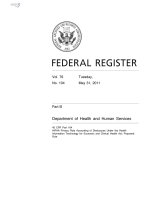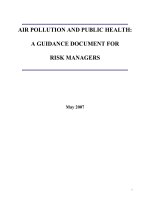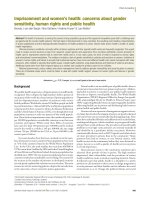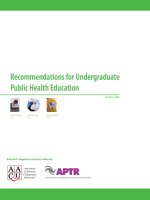TRADITIONAL, COMPLEMENTARY AND ALTERNATIVE MEDICINE Policy and Public Health Perspectives potx
Bạn đang xem bản rút gọn của tài liệu. Xem và tải ngay bản đầy đủ của tài liệu tại đây (22.55 MB, 472 trang )
Gerard Botfeke.-.
Gemma Burford
editors
TRADITIONAL,
COMPLEMENTARY AN
ALTERNATIVE MEDICINE
Policy and Public Health Perspectives
Imperial College Press
m,,
TRADITIONAL,
COMPLEMENTARY AND
ALTERNATIVE MEDICINE
Policy and Public Health Perspectives
TRADITIONAL,
COMPLEMENTARY AND
ALTERNATIVE MEDICINE
Policy and Public Health Perspectives
editors
Gerard Bodeker
Gemma Burford
Oxford University, UK
(Q^
Imperial College Press
Published by
Imperial College Press
57 Shelton Street
Covent Garden
London WC2H 9HE
Distributed by
World Scientific Publishing Co. Pte. Ltd.
5 Toh Tuck Link, Singapore 596224
USA office: 27 Warren Street, Suite 401-402, Hackensack, NJ 07601
UK office: 57 Shelton Street, Covent Garden, London WC2H 9HE
British Library Cataloguing-in-Publication Data
A catalogue record for this book is available from the British Library.
TRADITIONAL, COMPLEMENTARY AND ALTERNATIVE MEDICINE
Policy and Public Health Perspectives
Copyright © 2007 by Imperial College Press
All rights reserved. This book, or parts thereof, may not be reproduced in any form or by any means,
electronic or mechanical, including photocopying, recording or any information storage and retrieval
system now known or to be invented, without written permission from the Publisher.
For photocopying of material in this volume, please pay a copying fee through the Copyright
Clearance Center, Inc., 222 Rosewood Drive, Danvers, MA 01923, USA. In this case permission to
photocopy is not required from the publisher.
ISBN-13 978-1-86094-616-5
ISBN-10 1-86094-616-X
Typeset by Stallion Press
Email:
Printed in Singapore by Mainland Press
CONTENTS
Contributors
IX
xv
Foreword
POLICY
Introduction
Gerard Bodeker and Gemma Burford
Chapter 1
Policy and Public Health Perspectives on
Traditional, Complementary and Alternative
Medicine: An Overview
Gerard Bodeker, Fredi Kronenberg and
Gemma Burford
Chapter 2
Financing Traditional, Complementary and
Alternative Health Care Services and Research
Gemma Burford, Gerard Bodeker and
Chi-Keong Ong
41
Chapter 3
Training
Gerard Bodeker, Cora Neumann, Chi-Keong Ong
and Gemma Burford
61
Chapter 4
Safety: Issues and Policy
Gilbert Shia, Barry Noller and Gemma Burford
83
vi
Chapter 5
Chapter 6
Chapter 7
Chapter 8
Chapter 9
Contents
Pharmacovigilance of Herbal Medicines:
A United Kingdom Perspective
Joanne Barnes
Medicinal Plant Biodiversity and Local
Healthcare: Sustainable Use and
Livelihood Development
Gerard Bodeker and Gemma Burford
101
145
Home Herbal Gardens — A Novel
Health Security Strategy Based on Local
Knowledge and Resources
G. Hariramamurthi, P. Venkatasubramanian,
P. M. Unnikrishnan and D. Shankar
167
Humanitarian Responses to Traditional
Medicine for Refugee Care
Cora Neumann and Gerard Bodeker
185
Public-Private Partnerships: A Case Study
from East Africa
Patrick Mbindyo
205
PUBLIC HEALTH ISSUES: PRIORITY DISEASES
AND HEALTH CONDITIONS
Chapter 10
Malaria
Merlin L. Willcox and Gerard Bodeker
Chapter 11
HIV/AIDS: Traditional Systems of Health Care
in the Management of a Global Epidemic
Gerard Bodeker, Gemma Burford,
Mark Dvorak-Little and George Carter
239
255
Contents
Chapter 12
An Overview of Clinical Studies on
Complementary and Alternative Medicine
in HIV Infection and AIDS
Jianping Liu
vn
295
Chapter 13
Skin and Wound Care: Traditional, Complementary
and Alternative Medicine in Public Health
Dermatology
311
Gemma Burford, Gerard Bodeker and
Terence J. Ryan
Chapter 14
Traditional Orthopaedic Practices: Beyond
'Bonesetting'
Gemma Burford, Gerard Bodeker and
Jonathan Cohen
349
RESEARCH
Chapter 15
Clinical Trial Methodology
Ranjit Roy Chaudhury, Urmila Thatte
and Jianping Liu
389
Chapter 16
Ethical Issues in Research
Merlin L. Willcox, Gerard Bodeker and
Ranjit Roy Chaudhury
405
Chapter 17
Intellectual Property Rights
Gerard Bodeker
419
Epilogue
Gerard Bodeker and Gemma Burford
433
Index
437
CONTRIBUTORS
Joanne Barnes
Associate Professor in Herbal Medicines
School of Pharmacy
Faculty of Medical and Health Sciences
University of Auckland
Grafton Campus
Private Bag 92019
Auckland, New Zealand
Gerard Bodeker
University of Oxford Medical School, UK
and Adjunct Professor of Epidemiology,
Mailman School of Public Health
Columbia University, New York, USA
Chair, Global Initiative For Traditional Systems (GIFTS) of Health
Oxford OX2 6HG, UK
Gemma Burford
Senior Associate
Global Initiative For Traditional Systems (GIFTS) of Health
Oxford, UK
and International Programme Manager
Aang Serian (House Of Peace)
P.O. Box 13732, Arusha, Tanzania
IX
X
Contributors
George Carter
Director
Foundation for Integrative AIDS Research (FIAR)
62 Sterling Place, Suite 2
Brooklyn, NY 11217, USA
Ranjit Roy Chaudhury
Professor and Chairman, The INCLEN Trust and INCLEN Inc
161-L Hans Mansion
1st Floor, Left Wing
Gautam Nagar
New Delhi 110 048, India
Jonathan Cohen
Specialist Registrar
Department of Paediatric Infectious Diseases
Great Ormond Street Hospital
Great Ormond Street
London WC1N 3JH, UK
Mark Dvorak-Little
Stanford Graduate School of Business
350 Memorial Way
Stanford, CA 94305-5015, USA
Govindaswamy Hariramamurthi
Convenor, Medicinal Plants Conservation Network
Foundation for Revitalization of Local Health Traditions (FRLHT)
74/2 Jarakbande Kaval, Attur. P.O, Yelahanka
Bangalore 560 064, India
Fredi Kronenberg
Director, The Rosenthal Center for Complementary and
Alternative Medicine
Columbia University, College of Physicians and Surgeons
630 W. 168th Street, Box 75
New York, NY 10032, USA
Contributors
Jianping Liu
Professor and Director
Evidence-Based Chinese Medicine Center for Clinical Research
and Evaluation
School of Preclinical Medicine
Beijing University of Chinese Medicine
Bei San Huan Dong Lu 11
Chaoyang District
Beijing 100029, China
Patrick Mbindyo
Newborn and Child Health Group
Kemri-Wellcome Trust-University of Oxford Collaborative Prog
P.O. Box 43640-00100
Nairobi, Kenya
Cora Neumann
Department of International Development
Queen Elizabeth House
University of Oxford
Oxford OX1 3TB, UK
Barry Noller
National Research Center for Environmental Toxicology
The University of Queensland
39 Kessels Road
Coopers Plains, QLD 4108
Australia
Chi-Keong Ong
Head of Service Development and Palliative Care Studies
The Shakespeare Hospice
Church Lane, Shottery
Stratford-upon-Avon, CV37 9UL
and Associate Research Fellow
Centre for Primary Health Care Studies
Warwick Medical School
University of Warwick
Coventry CV4 7AL, UK
Xll
Contributors
Allan Rosenfield
Dean, Mailman School of Public Health
Columbia University
722 West 168th Street, Suite 1408
New York, NY 10032, USA
Terence J. Ryan
Emeritus Professor of Dermatology
University of Oxford and Oxford Brookes University
Hill House, Abberbury Avenue
Iffley, Oxon OX44EU, UK
Darshan Shankar
Director
Foundation for Revitalization of Local Health Traditions (FRLHT)
74/2 Jarakbande Kaval, Attur. P.O, Yelahanka
Bangalore 560 064, India
Gilbert Shia
Clinical Fellow
Chinese Medicine Advisory Service
Medical Toxicology Unit
Guy's and St. Thomas' Hospital Trust
Avonley Road
London SE14 5ER, UK
Urmila Thatte
Professor and Head
Department of Clinical Pharmacology
TN Medical College and BYL Nair Hospial
Mumbai Central
Mumbai 400 008, India
Unnikrishnan Pay \ appallimana
Senior Program Officer
Traditional Systems of Medicine Unit
Foundation for Revitalisation of Local Health Traditions (FRLHT)
74/2 Jarakbande Kaval, Attur. P.O, Yelahanka
Bangalore 560 064, India
Contributors
Padma Yenkatasubramanian
Joint Director
Foundation for Revitalisation of Local Health Traditions (FRLHT)
74/2, Jarakabande Kaval
Attur Post via Yelahanka
Bangalore 560 064, India
Merlin L. Willcox
Honorary Secretary
Research Initiative for Traditional Antimalarial Methods (RITAM)
36 Hare Close
Buckingham MK18 7EW, UK
xm
FOREWORD
In many parts of the world, where medicines are not readily available
or affordable, the public continue to rely on medicines used traditionally in their cultures. At the same time, affluent consumers in the industrialized world are spending their own money on healthcare approaches
that fall outside what has been considered mainstream medicine. A growing body of national and international studies highlight the reality that
there is exponential growth of global interest in and use of traditional (i.e.
indigenous), complementary and alternative medicine (TCAM). The scale
of this is so sizeable that it constitutes a public health phenomenon in
itself.
There is considerable use of traditional medicine in many developing
countries: 40% in China and Colombia; 71% in Chile; and up to 80% in
some African countries (World Health Organization Global Atlas on Traditional, Complementary & Alternative Medicine, Bodeker et al, 2005). In a
number of industrialized countries, almost half of the population now regularly uses some form of CAM, while the figures for Canada and Germany
are 70% and 71-75% respectively, and Australians spend more on complementary medicines than on pharmaceutical drugs. In the US, Americans
now make more visits to complementary practitioners than to primary
care physicians and spend more on complementary therapies than on
hospitalizations.
Individuals seek to avoid long-term use of pharmaceuticals, with their
potential for side effects. Thus, chronic conditions including pain conditions are a major reason that people seek the help of CAM practitioners.
Women outnumber men in their use of CAM, often by 2:1. CAM use is also
XV
XVI
Foreword
associated with higher education, higher income and strong environmental
values.
Naturally, governments have become increasingly focussed on the
public's need to be assured of safety, reliability and a beneficial therapeutic outcome from the healthcare choices that they make. Accordingly,
these societal trends have been matched in the past decade by a growing
momentum in regulation, research, policy development and professional
education.
Drawing on data from policy studies, and in areas of priority in international health, such as malaria and HIV, as well as in the areas of common ailments such as skin conditions and fractures, this book provides a
unique and important overview of the major trends of relevance to public health and health policy. After almost two decades of international
research into the clinical and experimental dimensions of complementary
and traditional therapies, this newer focus on the public health and policy
dimensions will bring research and policy attention to a new and wider
set of questions. These include: evidence based decision-making, the costeffectiveness of TCAM treatments compared with other more mainstream
approaches to managing health and disease; how the health and safety of
populations is impacted by TCAM use; and how TCAM providers can
best partner with mainstream healthcare colleagues to deliver AIDS and
malaria prevention messages and to communicate information on healthy
lifestyles.
The focus on population trends in self-medication, expenditures on
alternative healthcare modalities, healthcare outcomes for TCAM and
chronic disease, and the prospects for low-cost and locally available
methods of disease prevention and management is timely. Indeed, it is
overdue in view of the widespread and long-standing use of TCAM
globally.
By providing a public health and policy perspective, the various chapters in this book illustrate a basis for effective integration of services
for the benefit of the public, and potentially for cost-savings to governments through effective means of prevention and affordable methods of health maintenance and disease control. The book brings together
a global overview of the challenges, promise and professional requirements of a vast area of health care practice that is now international
Foreword
xvii
in scope and worthy of increased attention and analysis. The single
most important challenge for the future is to provide solid evidencebased decision making, as has been done recently in the area of malaria
therapy.
Allan Rosenfield, MD, FACOG
DeLamar Professor of Public Health and Ob/Gyn
Dean, Mailman School of Public Health
Columbia University
New York, USA
POLICY
INTRODUCTION
Gerard Bodeker and Gemma Burford
It is now well established that interest in traditional, complementary and
alternative medicine (TCAM) is rising rapidly throughout the world. Policymakers, consumers and professional organisations have been calling variously for greater evidence, integration of TCAM and modern medical
services; public sector support for TCAM services; and comprehensive
national policy for what has been a consumer-led trend in most countries. Some countries, notably China, India and a number of other Asian
nations, have been working actively to build the TCAM sector for the combined motives of perpetuating tradition and promoting cost-effectiveness
in health services. In addition, there has been a dawning awareness of the
significant export potential of traditional medicines in a burgeoning global
marketplace for herbal medicines. This economic incentive has strengthened the drive for increased levels of production and quality control.
At the same time as consumer demand is rising and policy-makers
are beginning to respond with moves to formalise TCAM within national
policy, it is widely recognised that the indigenous sources of medical knowledge are disappearing and that there is a substantial inter-generational loss
of traditional medical knowledge, especially within the oral traditions of
the world (Posey, 2000). In these traditions, health knowledge extends to
an appreciation of both the material and non-material properties of plants,
animals and minerals. Their classificatory systems range in scope from the
3
4
G. Bodeker & G. Burford
cosmological to the particular in addressing the physiological makeup of
individuals and the specific categories of materia medica needed to enhance
health and well-being. Mental, social, emotional, spiritual, physical and
ecological factors are all taken into account. In establishing policy, these
fundamental theoretical underpinnings of traditional health systems may
either be respected and perpetuated, or converted into a biomedical expression and agenda. These approaches result in very different prospects for
traditional medical knowledge and its continuity as a cultural health care
resource.
With such a wide spectrum of approaches to TCAM at national and
local levels, and the growing trend towards global and regional analysis of
utilisation patterns and formalisation, there is now a clear need for a set of
public health and policy perspectives to provide models and reference points
for planners, policy-makers, programme developers and practitioners.
A broad policy overview and study of trends in utilisation and regulatory
and policy development can be found in the World Health Organisation's
Global Atlas of Traditional, Complementary and Alternative Medicine
(Bodeker et ai, 2005). Based around a set of standardised core indicators,
the WHO Global Atlas on TCAM provides information on the context,
levels of use, structure and processes of TCAM at national, regional and
global levels.
The Atlas, coordinated and edited by teams at Oxford University and the
London School of Hygiene and Tropical Medicine, draws on data gathered
by regional teams from Africa, the Americas, the Eastern Mediterranean,
Europe, the Western Pacific, and South and South-East Asia. It comprises
a map volume and a text volume. Through global and regional maps and
tables, the former provides a visual representation of topics such as the
popularity of herbal/traditional medicine, Ayurveda, Siddha, Unani, traditional Chinese medicine, homeopathy, acupuncture, chiropractic, osteopathy, bone-setting, spiritual therapies, and others; national legislation and
traditional medicine policy; public financing; legal recognition of traditional medicine practitioners by their area of therapy; education and professional regulation; conventional health care practitioners who are entitled
to provide various traditional, complementary and alternative therapies; and
many other aspects. The text volume expands and supplements the map
Introduction
5
volume through detailed accounts of the development of traditional, complementary and alternative medicine in 23 countries across the world, as
well as overviews of their status in each of the six WHO Regions.
Through these two volumes, a global picture of the development of traditional, complementary and alternative medicine becomes evident, revealing people's belief in and dependence on different traditional health systems
around the world.
In the context of producing this first attempt at generating a systematic
global overview of TCAM, what became apparent was that there is less
data available on TCAM than the coordinating or regional teams would
have wished, thus making mapping and policy analysis a more approximate
exercise than was considered ideal. What this data collection exercise did
reveal, however, is the wide spectrum of stages of policy development
across regions, and among countries within regions. Interestingly, the global
trend has shifted from being led by consumers and advocacy groups of
practitioners, to a situation in most countries where governments are now
working towards establishing a full regulatory context for the practice and
use of TCAM. At one end of the spectrum, there are countries that formally
promote and finance TCAM development, while at the other end, there are
countries where the process of national recognition and regulation has not
yet begun. For the countries in between, the picture is one of emerging
policy, legislation and investment, with varying degrees of autonomy for
the different TCAM professions. What is little known, other than in a very
few industrialised countries, is the full extent of TCAM use by the public.
At a global level, the often-cited 1983 estimate by Bannerman et al. that
'over 80% of the world's population relies on traditional medicine for its
primary health care needs' has neither been updated, nor analysed in detail.
In particular, little research has been conducted on the differing patterns
of TCAM utilisation according to disease, income, gender, geography and
culture.
Our work on the WHO Global Atlas on TCAM led to the realisation that,
in addition to gaps in comparative policy studies of this sector, there was
also a dearth of public health models for countries to draw on in planning
health services and in integrating TCAM — either fully or selectively —
into national health care.
6
G. Bodeker & G. Burford
Accordingly, drawing in part on data from the WHO Global Atlas, with
permission of WHO Kobe, the sponsor of this project, we have assembled
a set of policy-related chapters that analyse trends across a set of key policy
issues such as regulation, education, safety, and finance within the TCAM
sector.
We extend our appreciation and recognition to all who participated in
the massive global data collection exercise and who are listed by name in
the WHO Global Atlas. It is this data that has been analysed and commented
on in the first four chapters of this volume.
At the same time, we were also aware that there exist important public
health models, policy examples, NGO programmes and other TCAM innovations which highlight more fundamental principles of health planning,
service development and public health outcomes. Accordingly, this volume
brings together a sample of these. These include a model for self-sufficiency
in family medicines through the production of home herbal gardens and data
on significant public health benefits that have resulted; and an approach
to harnessing the indigenous health knowledge and provider networks in
refugee communities as a means of providing basic health needs and mental
health through the use of locally available and culturally familiar strategies
in an environment where most links with heritage and home have been
shattered. Priority diseases such as malaria and HIV/AIDS are also considered from the perspective of TCAM as are common ailments such as skin
conditions. Finally, resource rights issues are addressed through discussions of sustainability in medical plant use and in the intellectual property
issues associated with the development of traditional medical knowledge
for commercial purposes.
It is an intentionally eclectic and broad-based set of perspectives,
designed to illustrate the wide range of work being done in this field. It
is simply a beginning. Future work will inevitably build on, differentiate and diverge from these perspectives to create new directions, analytic
frameworks and frames of reference for service development and integrated
health care delivery in TCAM.
We would like to thank all of the contributors to the book, to WHO
Kobe for allowing the use of data from the WHO Global Atlas in the first
four chapters, and all who generated this data in the production of the WHO
Global Atlas. We also recognise the work of many NGOs and community
Introduction
7
groups who are pioneering important public health initiatives at the local
level in combating major diseases and common ailments through the use
ofTCAM.
References
Bannerman RH, Burton J, Wen-Chieh C. Traditional Medicine and Health Care
Coverage: A Reader for Health Administrators and Practitioners. Geneva:
World Health Organization, 1983.
Bodeker G. Lessons on integration from the developing world's experience.
Br Med J 2001;322:164-167.
Bodeker G. Planning for cost-effective traditional health services. In: Traditional Medicine: Better Science, Policy and Services for Health Development. Proceedings of a WHO International Symposium, Awaji Island, Hyogo
Prefecture, Japan, 11-13 September 2000. Kobe: WHO Centre for Health
Development, 2001, pp. 31-70.
World Health Organization. WHO Traditional Medicine Strategy 2002-2005.
Geneva: World Health Organization, 2002 (WHO/EDM/TRM/2002.1).
World Health Organization Centre for Health Development. Traditional Medicine:
Better Science, Policy and Services for Health Development. Proceedings of
a WHO International Symposium, Awaji Island, Hyogo Prefecture, Japan,
11-13 September 2000. Kobe: WHO Centre for Health Development, 2001.
World Health Organization Centre for Health Development. Global Information on Traditional Medicine/Complementary and Alternative Medicine:
Practices and Utilization. Proceedings of WKC International Consultative
Meeting, Kobe, Japan, 19-21 September 2001. Kobe: WHO Centre for Health
Development, 2002.









